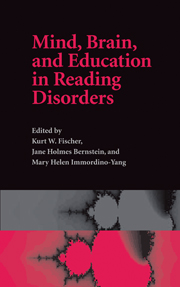Book contents
- Frontmatter
- Contents
- List of figures
- List of tables
- List of contributors
- Acknowledgements
- Part I What is Reading, and What are Reading Disorders? Looking to Neuroscience, Evolution, and Genetics
- Part II Reading and the Growing Brain: Methodology and History
- 4 A brief history of time, phonology, and other explanations of developmental dyslexia
- 5 Approaches to behavioral and neurological research on learning disabilities: in search of a deeper synthesis
- 6 Growth cycles of mind and brain: analyzing developmental pathways of learning disorders
- Essay: Cycles and gradients in development of the cortex
- 7 Brain bases of reading disabilities
- 8 The neural correlates of reading disorder: functional magnetic resonance imaging
- 9 Patterns of cortical connection in children with learning problems
- Essay: The role of experience in brain development: adverse effects of childhood maltreatment
- Part III Watching Children Read
- Part IV Reading Skills in the Long Term
- Appendix: Transcript and behavioral data from Profiles in Reading Skills (Four Boys)
- Index
9 - Patterns of cortical connection in children with learning problems
Published online by Cambridge University Press: 22 September 2009
- Frontmatter
- Contents
- List of figures
- List of tables
- List of contributors
- Acknowledgements
- Part I What is Reading, and What are Reading Disorders? Looking to Neuroscience, Evolution, and Genetics
- Part II Reading and the Growing Brain: Methodology and History
- 4 A brief history of time, phonology, and other explanations of developmental dyslexia
- 5 Approaches to behavioral and neurological research on learning disabilities: in search of a deeper synthesis
- 6 Growth cycles of mind and brain: analyzing developmental pathways of learning disorders
- Essay: Cycles and gradients in development of the cortex
- 7 Brain bases of reading disabilities
- 8 The neural correlates of reading disorder: functional magnetic resonance imaging
- 9 Patterns of cortical connection in children with learning problems
- Essay: The role of experience in brain development: adverse effects of childhood maltreatment
- Part III Watching Children Read
- Part IV Reading Skills in the Long Term
- Appendix: Transcript and behavioral data from Profiles in Reading Skills (Four Boys)
- Index
Summary
Overview: Behavior is based on brain functioning, and measures of brain activity such as the electroencephalogram (EEG) provide powerful tools for analyzing the relation between brain and behavior, including learning and development. In a study of brain activity in children with learning disorders, which included two of the boys who are a focus of this book (Andrew and Brian), EEG coherence was used to measure connectivity among cortical regions. Learning problems were associated with reduced connectivity of the left mid-temporal region with a cluster of central, frontal, and parietal locations: weaker connections seemed to relate to learning problems. Limited connectivity among brain regions also appears to characterize many victims of child abuse, as discussed in an Nessay for this chapter by Martin Teicher. At the same time, caution is required because of methodological issues about interpretation of brain activity measures, which are still in their infancy.
The EditorsThe neurological perspective on behavior is based on the assumption that all behavior derives from the brain, a position based on lesion studies and aphasia. Having had the privilege of working with people such as Derek Denny-Brown, Ray Adams, and Norman Geschwind, all of whom contributed enormously to the understanding of brain–behavior relationships based on studies of brain lesions, I find this position difficult to resist. Indeed, it is amazing what complex patterns of behavior can be produced by very simple lesions that simply unhook key portions of a neural network that is otherwise functional.
- Type
- Chapter
- Information
- Mind, Brain, and Education in Reading Disorders , pp. 168 - 175Publisher: Cambridge University PressPrint publication year: 2007



